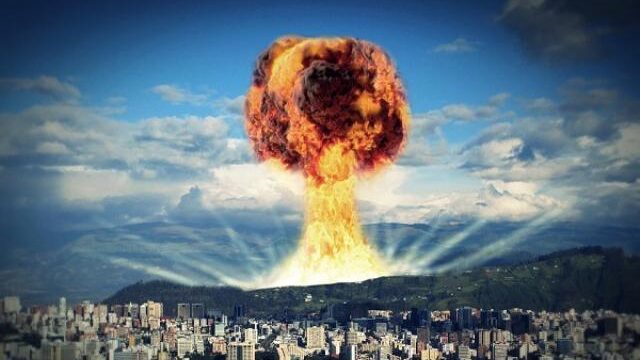Wars and Rumors of Wars

The older I get, the more suspiciously I look at the causes of war. This is natural. Young people — especially young men — are incapable of properly evaluating risk. Though they are rebellious, they also follow orders from authority figures. There is a reason why eighteen-year-olds are sent over embankments to cross open fields on the frontlines: They can be convinced to pursue success and ignore mortality. Courageous young men look right past danger. Only years later do they ask themselves, “Why the hell did I do that?”
There is no question that we are being psychologically prepped for a great and terrible war. Whether you are a civilian, veteran, or active service member, you surely have heard over the last ten years at least one commanding officer describe publicly the likelihood of a U.S.-China war or wider WWIII in the near future.
European politicians have been instructing their citizens to prepare for a full-on military conflict with Russian forces since the current war in Ukraine began. Such civilian war preparations have not been limited to the Baltic states, Finland, or Poland. France and the United Kingdom have spent the last several years conditioning citizens to expect bloodshed with the Russian Federation.
During the half-century Cold War, violence operated mainly in the shadows and through “proxies” so that the United States and the Soviet Union could at least pretend they were not directly fighting one another. Such was the shared fear of nuclear weapons — and of mutually assured destruction — that even bitter enemies did what they could to limit runaway escalation. The Moscow-Washington hotline — or what Hollywood mythologized as the doom-averting “red phone” — was established because both sides understood the stakes of WWIII.
Cold War warriors generally took to heart a quote attributed to Albert Einstein: “I know not with what weapons World War III will be fought, but World War IV will be fought with sticks and stones.” With this warning lingering in the minds of men who could unleash global annihilation with the pressing of a few buttons, humanity has somehow avoided destroying itself in the eighty years since the atomic bombings of Hiroshima and Nagasaki.
In my estimation, the mood has radically changed over the last fifteen years. A more cavalier attitude toward the use of nuclear weapons has replaced decades-long angst and circumspection. Senators, generals, and even diplomats publicly make the case for the use of terrible weapons that could easily lead to mass slaughter on a scale never before witnessed. Gone are the days of worrying about the end of life as we know it. In their place, a new generation of military and political leaders seem to be not so quietly echoing a spine-chilling refrain: How will nuclear weapons deter our enemies if we are habitually afraid to use them?
Five years after mass hysteria concerning COVID convinced much of the world to shut down for no good reason, more people are familiar with the concept of “mass formation psychosis.” Simply stated, this phenomenon exists when large numbers of people believe in something detached from reality. I put COVID in the same category as man-made “climate change.” I believe that a large percentage of the global population has been manipulated to believe that both are much more dangerous than they really are.
For hundreds of years, academic studies have shown how political leaders exploit the “madness of crowds” to their advantage. In the early twentieth century, “propaganda” even had a positive connotation, as the “elites” of the day argued that “educated” people have a moral duty to corral the masses. In Public Opinion, writer Walter Lippmann argues explicitly that “experts” should use a combination of propaganda and censorship to “manufacture” the consent of the “bewildered herd.” If the “educated” class finds it useful to scare the dickens out of humanity with regard to coronaviruses and carbon dioxide, it will do so.
With this in mind, it is entirely possible that I am serving as a useful idiot when it comes to worries over WWIII. Perhaps I am doing exactly what Lippmann’s disciples wish me to do by professing my genuine concerns regarding the devastating global conflict heading our way. It still feels like yesterday, however, when I was reading of the likelihood of Islamic terror attacks on U.S. soil years before the murder of 3,000 Americans on September 11, 2001. Now I read and hear similar predictions for a great war ahead, and I cannot help but be filled with terrible dread.
As with all matters involving mass communication and public opinion, the whole thing devolves into a “chicken or the egg” quandary rather fast. Am I writing about WWIII because so many signs indicate that it will arrive within the decade? Or am I inadvertently pushing what I wish to avoid by helping to convince society that it is imminent? Putting the dilemma of causality aside, I will say that I learned long ago that the war machine first prepares the public for conflict in the information space before officially firing weapons on the battlefield.
As distasteful as it sounds, the military considers civilian minds part of the overall battlespace during war. Before every conflict begins, the social consciousness is shaped to accept, expect, and engage in battle. It feels as if we are being directed toward global war today.
Such an assertion might appear strange coming in the same week that President Trump is brokering peace in the Middle East. Even casual students of war would expect that region of the world to be fully enflamed during any true global conflict. Yet there are over fifty other conflicts raging around the world today, and over ninety countries are involved in battles beyond their territorial borders. Although some Western societies can be hypnotized into believing that the world is enjoying relative peace, war is spreading faster today than it has since WWII. Even with so much bloodshed, though, we have seen nothing that approaches the level of violence that will unfold should the Russia-Ukraine war transform into a U.S.-Russia war or simmering tensions between China and Taiwan transform into a direct showdown between the U.S. and China.
For the last decade, military academics have been predicting a global war by 2030. Suspiciously, that is the date that the World Economic Forum, United Nations, and other globalist institutions have been highlighting as a universal “pivot” for humanity. Artificial intelligence is evolving quickly. Plans for mandatory digital identifications are taking hold across Europe. Central banks are designing government-controlled digital currencies. The European Union wants access to all private communications. As president, Joe Biden constructed a “disinformation board” to filter public information and censor dissent. The walls of a grand surveillance prison are being built all around us, while the same powers that be are preparing the public for economic hardship and prolonged war.
We may not like it. We may not want it. But it appears our “betters” expect us to take it in stride.
There is another option. It is at least possible that billions of humans on this planet learn to push back. Rather than permitting a handful of “elites” to dictate “public opinion,” the public might discover that it has some control over its opinions, too. If enough people refuse to engage in senseless slaughter, perhaps the globalists who wish to lead us to war will discover that no-one is much interested in following. Nothing so perfectly epitomizes the “madness of crowds,” after all, than millions of young people rushing carelessly into the madness of war.
For the sake of those who will otherwise lose their lives in the coming fights, I pray that wiser stewards of peace chart the course ahead.
https://www.americanthinker.com/articles/2025/10/wars_and_rumors_of_wars.html
